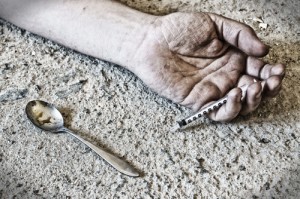Drug use can break down a user’s body over time and cause his mind to disintegrate as well, and sometimes this process is a long time coming. A drug user doesn’t always notice the changes overnight—they can take weeks, months or years to appear.
In other cases, though, drug use can cause immediate harm and death. The most obvious example is when a drug user overdoses. This means that the person takes too much of a drug and the effect he or she is going for is multiplied far beyond the level of “safety” (or, in other words, multiplied beyond the usual level of harm it would already inflict.) Drugs like heroin, for example, can suppress the respiratory system—they make it harder to breathe. If an addict takes too much heroin, or even painkilling drugs available at a pharmacy, he can suppress his breathing so far that he goes unconscious and dies. This is a drug overdose.
How Heroin Works in the Brain
The way that heroin gets a user high is by breaking down into several other drugs once it hits the brain. The brain can turn heroin into several forms of morphine, and these then bind to receptors where endorphins are usually meant to go. These are the brain’s chemicals that process pleasure and feeling good. When the morphine molecules block the receptors, a person feels so good he goes into a state of euphoria, and he can also stop feeling pain.
A new drug called naloxone can help treat an addict that has had an overdose. It binds to the same receptors that heroin affects so that it can reverse the endorphin flooding effect. Many hospitals and ambulances now have this drug on hand to inject into a person that has had an overdose. Because of naloxone, a heroin overdose patient can return to normal in minutes.
Spreading Out to Non-doctors
Instead of just being confined to doctors and EMTs in ambulances, the general public is now starting to get its hands on naloxone. Rumors have spread over how effective and life-saving it can be, so why not keep some on hand if you or someone you know uses heroin?
Several states have already passed laws to make the drug legal for distribution to the general public without restrictive prescriptions. Also, a number of community programs are trying to spread the drug around throughout the communities that are hit hardest by drug overdose deaths. If more people have naloxone on hand, more lives can be saved. Already, regular people have saved the lives of thousands of addicts that would otherwise no longer be with us.
One Drawback to Naloxone Use
There is one potential problem with naloxone. It doesn’t appear to have any impurities or deficiencies or side effects. The problem is one of perception and use. While the drug is saving lives, some observers fear that it may also be prolonging drug use unnecessarily.
Think of it this way: there are many dangerous activities that we don’t do every day because we know they could hurt or kill us. We don’t jump off of high buildings or stick our fingers in light sockets (at least, we don’t on purpose.) What if you could do these things because there was a seemingly magic way to fix your body right afterward?
In a way, naloxone is that magical cure-all for heroin users. Instead of just being a crutch to continue drug use, then, naloxone must be used in conjunction with effective drug rehabilitation programs to ensure that addicts can permanently get on the path to sobriety.
